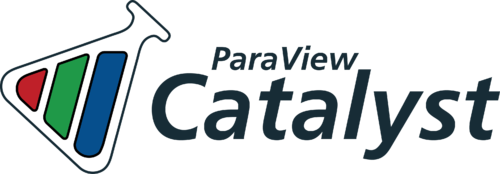ParaView/Catalyst/Overview: Difference between revisions
Andy.bauer (talk | contribs) |
Andy.bauer (talk | contribs) m (→Background) |
||
| Line 1: | Line 1: | ||
<center>[[File:CatalystLogo.png|500px]]</center> | <center>[[File:CatalystLogo.png|500px]]</center> | ||
== Background == | == Background == | ||
Several factors are driving the growth of simulations. Computational power of computer clusters is growing, while the price of individual computers is decreasing. Distributed computing techniques allow hundreds, or even thousands, of computer nodes to participate in a single simulation. The benefit of this computational power is that simulations are getting more accurate and useful for predicting complex phenomena. The downside to this growth is the enormous amounts of data that need to be saved and analyzed to determine the results of the simulation. | Several factors are driving the growth of simulations. Computational power of computer clusters is growing, while the price of individual computers is decreasing. Distributed computing techniques allow hundreds, or even thousands, of computer nodes to participate in a single simulation. The benefit of this computational power is that simulations are getting more accurate and useful for predicting complex phenomena. The downside to this growth is the enormous amounts of data that need to be saved and analyzed to determine the results of the simulation. Unfortunately, the growth of IO capabilities has not kept up with the growth of processing power in these machines. Thus, the ability to generate data has outpaced our ability to save and analyze the data. This bottleneck is throttling our ability to benefit from our improved computing resources. Simulations save their states only very infrequently to minimize storage requirements. This coarse temporal sampling makes it difficult to notice some complex behavior. To get past this barrier, ParaView can now be easily used to integrate concurrent analysis and visualization directly with simulation codes. This functionality is often referred to as co-processing, ''in situ'' processing or co-visualization. | ||
This feature is available through ParaView Catalyst (previously called ParaView Co-Processing). The difference between workflows when using ParaView Catalyst can be seen in the figures below. | This feature is available through ParaView Catalyst (previously called ParaView Co-Processing). The difference between workflows when using ParaView Catalyst can be seen in the figures below. | ||
[[File:FullWorkFlow.png|thumb|center|800px|Full Workflow]] | [[File:FullWorkFlow.png|thumb|center|800px|Full Workflow]] | ||
[[File:CatalystWorkFlow.png|thumb|center|800px|Workflow With Co-Processing]] | [[File:CatalystWorkFlow.png|thumb|center|800px|Workflow With Co-Processing]] | ||
== Technical Objectives == | == Technical Objectives == | ||
Revision as of 14:48, 28 July 2013

Background
Several factors are driving the growth of simulations. Computational power of computer clusters is growing, while the price of individual computers is decreasing. Distributed computing techniques allow hundreds, or even thousands, of computer nodes to participate in a single simulation. The benefit of this computational power is that simulations are getting more accurate and useful for predicting complex phenomena. The downside to this growth is the enormous amounts of data that need to be saved and analyzed to determine the results of the simulation. Unfortunately, the growth of IO capabilities has not kept up with the growth of processing power in these machines. Thus, the ability to generate data has outpaced our ability to save and analyze the data. This bottleneck is throttling our ability to benefit from our improved computing resources. Simulations save their states only very infrequently to minimize storage requirements. This coarse temporal sampling makes it difficult to notice some complex behavior. To get past this barrier, ParaView can now be easily used to integrate concurrent analysis and visualization directly with simulation codes. This functionality is often referred to as co-processing, in situ processing or co-visualization. This feature is available through ParaView Catalyst (previously called ParaView Co-Processing). The difference between workflows when using ParaView Catalyst can be seen in the figures below.
Technical Objectives
The main objective of the co-processing toolset is to integrate core data processing with the simulation to enable scalable data analysis, while also being simple to use for the analyst. The toolset has two main parts:
- An extensible and flexible library: ParaView Catalyst was designed to be flexible enough to be embedded in various simulation codes with relative ease and minimal footprint. This flexibility is critical, as a library that requires a lot of effort to embed cannot be successfully deployed in a large number of simulations. The co-processing library is also easily-extended so that users can deploy new analysis and visualization techniques to existing co-processing installations. The minimal footpring is through using the Catalyst configuration tools (see directions for generating source and building) to reduce the overall amount of ParaView and VTK libraries that a simulation code needs to link to.
- Configuration tools for ParaView Catalyst output: It is important for users to be able to configure the Catalyst output using graphical user interfaces that are part of their daily work-flow.
Note: All of this must be done for large data. The Catalyst library will often be used on a distributed system. For the largest simulations, the visualization of extracts may also require a distributed system (i.e. a visualization cluster).
Important Links
- The main page for ParaView Catalyst.
- The most complete information is available in the ParaView Catalyst User's Guide.
- Example code with samples from Python, C, C++ and Fortran for creating adaptors as well as examples of hard-coded C++ Catalyst pipelines.
- A tutorial on ParaView Catalyst along with sample files.
Information for ParaView's original co-processing tools are still available but are for versions of ParaView before 4.0.

